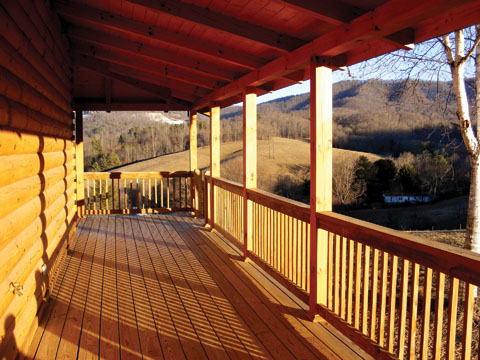A beautiful log home—it’s a great dream for anybody to have for their retirement years. Now imagine if that home required zero maintenance: No painting, no toilet repair, no worries … talk about a beautiful dream!
Of course, a home that doesn’t require any maintenance really is a dream. But what you can do is take steps during the planning process for your log home that will minimize maintenance in the long term. And that’s a dream that everybody can live with.
To help us come up with the best planning and design tips for reducing log home maintenance over time, we spoke with several of today’s top log home experts. Read these tips, and you can keep your dream log home from becoming a maintenance nightmare.
Create the Right Overhangs
One way to keep your logs looking great for longer is to keep the weather off them as much as possible. You can do this by simply increasing the distance by which your roof overhangs the sides of the home. “The normal overhang is typically 12 to 18 inches,” says Dorie Workman, vice president of marketing for Appalachian Log Structures in West Virginia. “But we like to do 24-inch or more overhangs.”
Another tip to avoid exposing your logs to the elements is to incorporate more doors, windows, porches, and other non-log elements into the design.
Keep Wood Up off the Ground
Where the walls of any home meet the ground is a major danger zone for insects and decay. The simple solution here is to make sure your concrete or masonry foundation extends well up off the ground. “The logs should be 18 to 24 inches off the ground at least,” says Workman. “Also, they should be somewhat open, so air can circulate to them.” That means keeping flowers, shrubs, and other plantings back away from the foundation a bit.
Keep the Trees at Arm’s Length
There’s no doubt that trees add beauty to your log home’s property, but when they’re too close to the house, they can cause a couple of problems. First, overhanging limbs and branches pose a real risk of falling and causing serious damage down the road. Second, the shade produced by the trees creates great places for moisture to pool and remain—and mold and mildew to grow.
Now, this doesn’t mean you need to clear-cut your property. Just be smart, and keep your trees a safe distance away from the home to avoid these future problems.
Choose Your Roof Wisely
Metal roofs are becoming increasingly popular on log homes. And though they cost more upfront, they provide outstanding longevity and durability. Another popular option that provides great durability is a cement-based roofing system. There are several cement options that mimic the look of shingles, shakes, or tiles that are now available.
Go Prefinished with Flooring
When it comes to flooring, Allen Halcomb, president of MossCreek Designs in Knoxville, Tennessee, says that both tile and stone are excellent low-maintenance choices that look great in a log home. Of course, many people want the look of natural hardwood as a complement to their cabin. Here, the choice today is simple, says Halcomb. “Prestained flooring with complete stain penetration is wonderful because it never has to be sanded, and it takes about a week out of the construction schedule,” he says.
Finish the Logs Right
The exterior finish of the logs themselves is obviously a major factor in the future maintenance of your log home. According to Sjoerd Bos, vice president of Sansin Corporation in Ontario, Canada, the answers aren’t as easy to come by here. Sjoerd says the major categories you’ll find are film-building finishes that lie on top of the wood, or penetrating finishes that soak into the wood. These are also available in oil-based and water-based varieties.
Each has its own unique pros and cons, but at the end of the day, Sjoerd’s top choice is a water-based, penetrating sealer for log homes. (For a more in-depth discussion about exterior finishes, go to www.logcabins.com.)
Keep an Eye on Things
Of course, no home is going to be completely free of maintenance, so it’s always a good idea to just keep a close eye on the various parts of your home as the months and years go by. As a general rule, catching problems and fixing them early is always easier than waiting until things get really bad!

